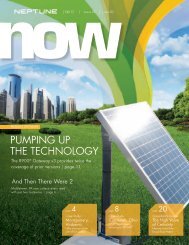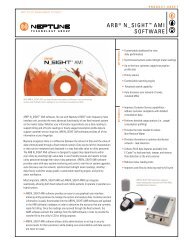AMI + H20 = ARB - Neptune Technology Group
AMI + H20 = ARB - Neptune Technology Group
AMI + H20 = ARB - Neptune Technology Group
Create successful ePaper yourself
Turn your PDF publications into a flip-book with our unique Google optimized e-Paper software.
<strong>AMI</strong>: A Definition Utilities Can Use – “About My Individual” Needs<br />
YOU CAN’T JUST PLUG IN ELECTRIC SOLUTIONS TO WATER<br />
The term “<strong>AMI</strong>,” or “Advanced Metering Infrastructure,” can mean different<br />
things to different people. Maybe even more important, it does mean very<br />
different things for different types of utilities.<br />
For instance, there is an agreed-upon definition of “advanced metering” for the<br />
electric industry. According to the Demand Response & Advanced Metering<br />
(DRAM) coalition, “[Advance metering involves] a system that collects timedifferentiated<br />
energy usage from advanced meters via a fixed network system,<br />
preferably two-way, on either an on-request or defined schedule basis. The<br />
system is capable of providing usage information to electricity customers,<br />
utilities and other parties on at least a daily basis and enables them to<br />
participate in and/or provide demand response products, services and programs.<br />
The system also supports additional features and functionality related to system<br />
operation and customer service, e.g., outage management, connect/disconnect,<br />
etc.” [Source: Demand Response & Advanced Metering Coalition, © 2008,<br />
website: http://www.dramcoalition.org/id19.htm.]<br />
This definition sounds as though it would apply to the water industry, too – but<br />
does it? Electric utilities, unlike water utilities, are primarily concerned with<br />
“shaving” peak loads. When the energy is used during the day is very important.<br />
That’s because electricity is generated shortly before consumption, and cannot<br />
be stored easily for use later, as with a water tower, tank, or reservoir. Electricity<br />
generation and distribution systems need to be built to address these peak usage<br />
periods. A successful electric <strong>AMI</strong> program therefore provides consumers with<br />
the time-of-use consumption data and time-based pricing to motivate them to<br />
change their usage habits, reducing peak demand. This in turn helps reduce the<br />
utility’s required infrastructure.<br />
Since water can be stored more readily than electricity, water utilities have a<br />
very different set of needs. Because water distribution systems are built to meet<br />
maximum consumption plus fire protection, resources can be pumped into<br />
storage when the demand is lower (typically at night). And because water is<br />
readily available upon demand, the volume used is more important than time of<br />
day that it is used.<br />
CUSTOM OFFERS THE BEST FIT<br />
From the differences between the electric and water industries, it’s easy to see<br />
that however an <strong>AMI</strong> system is defined, it should be based on the needs of a<br />
particular utility. Water utilities shouldn’t feel pressured to use existing “<strong>AMI</strong>”<br />
products designed for the electric market. Instead, they should demand a system<br />
that provides customized solutions for their own unique needs.<br />
Many metering companies have pushed the idea that only fixed base systems<br />
are truly “<strong>AMI</strong>.” However, a mobile system such as <strong>Neptune</strong>’s <strong>ARB</strong> ® Mobile <br />
offers added <strong>AMI</strong> functionality such as data logging and leak detection. In<br />
addition, many hybrid systems, consisting of a mix of primarily mobile and<br />
targeted fixed base components, serve equally well – if not better – than some<br />
fixed base systems, depending on the needs of the user.<br />
Systems that combine a solid-state absolute encoder, a radio frequency<br />
transmitter, and data collectors with WiFi or GPRS backhaul capability can offer<br />
the benefits utilities think of with “<strong>AMI</strong>”: more frequent meter reads; increased<br />
meter reading accuracy; leak, tamper, and reverse flow detection; data logging;<br />
the potential for daily or hourly reads; and greater efficiency with fewer<br />
personnel. And in some cases, a hybrid system may also offer greater versatility<br />
than a “pure” fixed base <strong>AMI</strong> solution.<br />
For instance, <strong>Neptune</strong>’s R900 ® WiFi Gateway and R900 ® GPRS Gateway can<br />
offer utilities the best of both mobile and fixed base worlds. Utilities using these<br />
<strong>AMI</strong> systems know that even if a storm knocks out the data collector(s), the<br />
R900 ® can also be read using a mobile system. An even greater advantage of<br />
<strong>Neptune</strong>’s <strong>ARB</strong> ® Hybrid System is its migratability. Eighty to ninety percent of a<br />
system’s cost is the customer premise equipment – what goes on a house or a<br />
meter. So when a utility can avoid replacing much of that infrastructure, it can<br />
save a great deal of time and money. Providing systems that maximize backward<br />
as well as forward compatibility, <strong>Neptune</strong> eases the burden on water utilities by<br />
minimizing stranded assets.
<strong>AMI</strong>: “About My Individual” Needs<br />
When <strong>Neptune</strong> meets with a utility, it asks questions to determine needs.<br />
What percentage of meters will have to be read daily? What are you looking<br />
for from your data? What geographic/infrastructure challenges do you face?<br />
Through this consultative process, the utility is free to discover an <strong>AMI</strong><br />
system based on the best value.<br />
Those utilities serving smaller or more rural areas, and that need accurate<br />
reads once a month, may decide that an all-mobile system works best, while<br />
still offering features such as leak detection. A utility that serves residential<br />
suburban neighborhoods as well as more concentrated areas downtown may<br />
opt for a hybrid system. A hybrid system also works well in targeting hardto-reach<br />
industrial, commercial, and institutional (ICI) meters, meters in<br />
vaults, or at high security locations such as airports. ICI customers can<br />
represent massive amounts of water flowing through each meter. The faster<br />
a utility can read these meters, the better the value provided.<br />
Still another ideal scenario for a hybrid system is university or other housing<br />
where there is large and frequent turnover among the residents; having R900<br />
WiFi or GPRS Gateways in place can help reduce the cost of special reads<br />
including move-ins and move-outs.<br />
And, for those water utilities that are ready to implement a full-scale fixed<br />
base system, <strong>Neptune</strong> offers <strong>ARB</strong> ® FixedBase , a System that employs<br />
advanced R450 RF technology and data collectors strategically positioned<br />
to maximize meter reading efficiency. <strong>Neptune</strong>’s <strong>ARB</strong> FixedBase System<br />
provides time-synchronized midnight meter reading; i.e., all meters are read<br />
a midnight. This facilitates Non-Revenue Water programs (daily water<br />
produced/purchased versus daily metered consumption for the entire system<br />
or specific district metering zones).<br />
In short, the definition of <strong>AMI</strong> or Advanced Metering Infrastructure needs to<br />
be left up to the water utility. Various options are available and they can be<br />
tailored to address your needs.<br />
References:<br />
• Demand Response & Advanced Metering Coalition, © 2008, website:<br />
http://www.dramcoalition.org/id19.htm.<br />
• Schlenger, Don and Hughes, David, © 2008, “AWWARF Project on <strong>AMI</strong><br />
Best Practices” (in progress, unpublished).




